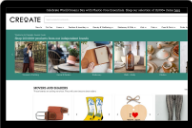
Boutique owners face a huge conundrum: with limited space, how do you offer all the products you want, without your shop becoming cluttered and uninviting?
CREOATE actually started life as a little boutique shop in London’s Covent Garden, and our founders had to quickly get to grips with how to maximise their space. Learning on the job, and from other boutiques and small independent shops they admired, here are their top tips for squeezing the most out of a small shop space
7 Space-saving boutique layout ideas
- Maximise wall space
- Don’t forget your floor space, too
- Invest in smart furniture
- Stock up on props
- Fill your window, and refresh it often
- Become storefront goals
- Create curb appeal
1. Maximise your wall space
With space at a premium, you need to maximise every available surface, including getting the most out of your wall space.
Fully fitted wall units will look the most put together, but when you’re just starting out, you can definitely minimise building work by using some cleverly designed freestanding shelves, rails, and pegboards.
Use the remaining wall space to display art work, mirrors (which will also help your space appear bigger) and hooks, all of which will be easier to put up yourself.
2. Don’t forget your floor space, too
Floor space is often overlooked, but using this space to your advantage will only soften up your retail space, giving it a cosy and lived-in feel, but it will also provide some much needed additional display space.
Get creative with baskets and barrels of varying heights to create a design focal point and draw your customer’s eye. When your stock changes, you can even flip them over to use as low tables.
💡 Top tip: As you add more to your shop floor, make sure you’re leaving a wide enough space for people to easily manoeuvre around your shop with a buggy or wheelchair, and also make sure to leave an empty ‘decompression zone’ at the very front. The last thing you want is to make people feel cramped once they’re inside, or they’ll be rushing straight back out.
.jpg?width=561&height=748&name=Hold5%20(1).jpg)
HOLD uses every level to create an interesting display, without being overwhelming
📚 Bookmark for later: 13 Retail Store Layouts & Customer Flow Tips
3. Invest in smart furniture
Now you’ve made the most of your wall and floor space, invest in some smart furniture to get the most out of the middle floor areas. Furniture such as tiered gondolas, nesting tables, and spinning displays give you the maximum surface area to display products on, while occupying as little floor space as possible, and keeping walkways clutter-free and clean for your customers.
💡 Top tip: Planning to host events, or rent out your shop space out of hours? Furniture that can be moved around and stacked up will be particularly useful if your boutique plans to host events and workshops as they can be stored away or moved to create extra space for visitors.

The Gardener's Shop in Holt is a great example of how to fill your small store from floor to ceiling, without it feeling chaotic
4. Stock up on props
When you’re browsing a shop as a customer, you may well not notice all the props and final details that go into building each display; the tiles, baskets, trays, tiered stands, and more.
But when you’re building your own shop displays, you’ll soon notice when you don’t have them!
They all add up, so if you’re just starting out, think about the types of products you will be stocking and how you can invest in some multipurpose organisational pieces such as baskets, statement tiles, trays, crates, tiered stands and more.
You will want these to either blend seamlessly with your furniture, or to be statement pieces of their own. So also start keeping an eye out at flea markets, antique shops and car boot sales for unique items you can repurpose in fun ways
5. Fill your window, and refresh it often
Whatever the size of your window, your window display is an essential and effective way to catch the attention of passers-by. Make the most out of every height level to squeeze the most value from it, and get more of your favourite products in the spotlight.
Keep in mind that this display will need to change often with the seasons or as new products arrive. We’ve spoken to other independent stores in the CREOATE community and found that it’s not uncommon to update them every fortnight, or even more frequently.
Take a leaf out of Laura’s book at Handmade Design Ashbourne when planning your window:
“Before I even begin playing with the window display, I simply sit down with a pen and paper and write down all the products that I feel would fit to my theme… Once I’m armed with my list, I put the large pieces in first (for us it’s furniture) and then I just start playing to see what works!” — Laura, Handmade Design Ashbourne
Ceiling hooks are a great way to create a floating display of items throughout the year. You can also get window decals or even collaborate with a local artist to commission something special just for your store.

Verandah makes the most out of each and every one of their little windows to attract people passing on all sides of their store
6. Become storefront goals
Your storefront is the first thing new customers see as they are driving or walking by, and the first impression of what they can expect once they’re inside.
Your first step is to decide whether you want to blend into your local community aesthetic, or stand out with a bold design.
Ultimately, the impression you give outside should reflect the types of products inside. Whether you stock quirky and unique gifts or rustic chic homeware, make sure these details speak to customers from the outside.
A lick of paint and some signage are a good place to start, but adding an A-board with more details will take this up a level, encouraging more people to come inside.
We love this quirky and colourful collaboration for BAM Bristol's shopfront!
7. Create curb appeal
If you have the relevant permissions or licences, making use of your pavement space is a great way to draw more attention to your shop, and make it look even more welcoming to customers.
Adding seating like a cute bench or chairs encourages potential customers to linger. And where customers linger, other customers will be intrigued to explore. So go ahead, and spread out into the street!
📚 Bookmark for later: How to Increase Footfall In-Store: 15 Strategies
Looking for more inspiration?
We’re always on the lookout for real-life layouts, merchandising, and shop windows we love. And we’ve gathered them (along with plenty of expert advice) into our popular guides for shop owners.
Now you’ve stocked up on savvy space-saving ideas, why not take a look at:
🎨 21 Window Display Ideas & Design Tips
🎨 15 Creative Shopfront Design Ideas to Try
🎨 20 Visual Merchandising Tips & Best Practices for 2024
FAQs
1. What’s the best layout to use for a boutique?
When you’re first deciding what to put where in your store, we recommend sketching out a shop layout based on one of the six most common store layouts. For a boutique, we think the aptly-named ‘Boutique layout’ (pictured below) works really well for independent shops working out of a small space!

2. How can I make my small store look bigger?
Keeping your store looking clear and uncluttered certainly helps! We’d also suggest sticking with a lighter colour palette for your store decor, and strategically using mirrors on the walls.








